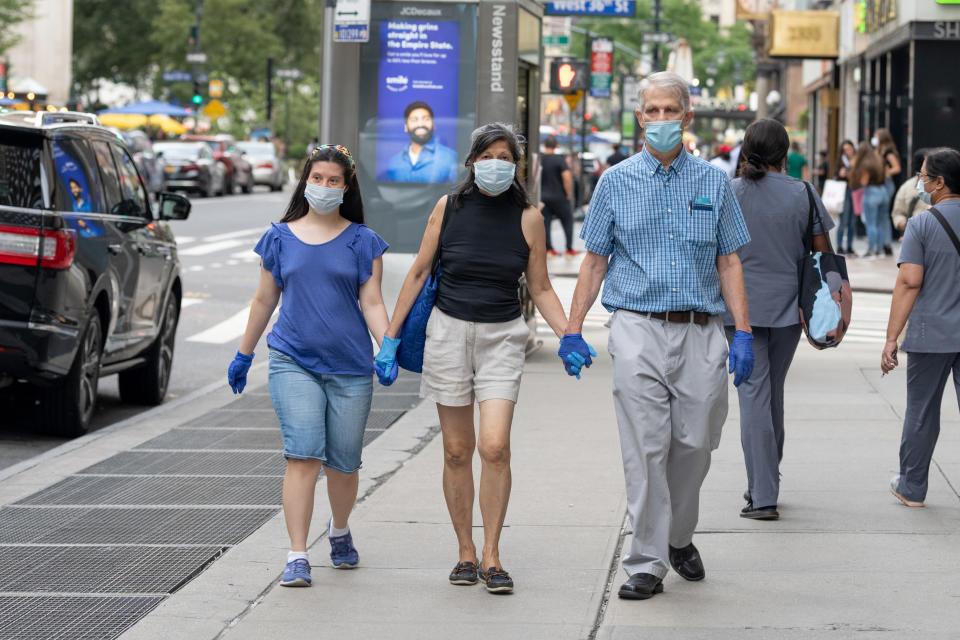Americans complied with coronavirus lockdowns, helping to curb pandemic, new CDC study finds
WASHINGTON — Virtually everywhere across the United States, people followed directives this spring to stay home to avoid contracting — or spreading — the coronavirus, a new study from the Centers for Disease Control and Prevention found, in contrast to media accounts of noisy demonstrations in favor of “opening up” locked-down states.
And medical researchers say that compliance helped reduce the spread of the coronavirus, which has killed more than 186,000 Americans.
While the CDC did not explicitly endorse a new round of lockdowns — though others have in recent weeks — it did say that its new findings, which clearly endorse the practice, could help inform decisions as the nation continues to battle the pandemic.
That isn’t likely to please President Trump, who has maintained that lockdowns do more harm than good.

The findings, which looked at county-by-county lockdown orders, offer a counter-narrative to the widespread images of anti-lockdown protesters crowding statehouses in Michigan, Ohio and elsewhere. Those images seemed to suggest there was a high degree of resistance to the lockdowns. Trump encouraged those protests and told governors like Gretchen Whitmer of Michigan, a Democratic nemesis of the president, to move more quickly to open their states up to economic and social activity.
“These are very good people, but they are angry,” Trump tweeted about the Michigan protesters, many of whom carried guns and few of whom wore masks. “They want their lives back again, safely!”
Some thought at the time that media coverage focused too intensely on the protests, ignoring the millions of Americans who complied with the measures. That compliance, the CDC concluded, was evident in nearly 98 percent of surveyed counties. And though the effect of locking down is still being studied, full national lockdowns in different countries “were significantly associated with increased patient recovery rates,” according to a study published in the Lancet last month.
The new CDC analysis does not describe how infection rates correlated to the length and severity of lockdown measures. Other studies, however, have shown that correlation to be exceptionally strong, which means that Americans almost certainly helped stop the spread of the coronavirus by staying home for much of the spring. Conversely, the lifting of lockdowns throughout the summer appears to have led to a spike in infections and fatalities, just as many epidemiologists predicted.
The lockdowns do appear to have worsened the impact of the pandemic on small businesses and contributed to the economic slowdown.
Trump has also maintained that lockdowns foster social isolation and exacerbate mental illness. A recent CDC study did paint a dire picture of Americans’ mental health and substance-use habits, though it did not link the rise in anxiety and depression to the lockdowns specifically.

The new study does not address the externalities associated with telling people to stay at home. Instead, it used mobile phone data to analyze lockdown orders or advisories in the 2,355 counties across the nation that issued them between March 1 and May 31. There were 878 counties that had no such orders at all, and that did not figure in the analysis.
The results show an overwhelming majority of Americans complying with the orders to some degree, with 97.6 percent of counties seeing “a significant decrease in movement” after lockdown orders went into effect. And since the coronavirus is airborne and spreads easily in spaces where people are crowded together, the lockdowns likely slowed the spread of the virus.
“Reduced population movement helps prevent close contact among persons outside the household, potentially limiting exposure to persons infected with SARS-CoV-2,” the authors said. “This suggests that stay-at-home orders can help protect the public’s health by limiting potential exposure to SARS-CoV-2 and reducing community transmission of COVID-19.” (SARS-CoV-2 is the internationally used name of the coronavirus, while COVID-19 is the disease that virus causes.)
The carefully worded conclusions reflect the CDC’s tenuous standing within the current administration. Trump has frequently sidelined the nation’s leading public health agency, dismissing its findings and conclusions. If the CDC explicitly endorsed lockdowns, that could lead to a fresh round of criticism.
And yet evidence in favor of lockdowns is strong, difficult as they may be to bear. A study published in the Annals of Medicine and Surgery, a British journal, in June, found that “the spread of the virus can be significantly reduced by this preventive restriction.”
The new findings from the CDC suggest that lockdowns “might influence behaviors in other areas.” In other words, the lockdowns signaled to people that they should take the pandemic seriously. In some states, like Florida and Georgia, governors refused to issue such orders or rushed to lift those orders soon after imposing them. Big-city mayors like Atlanta’s Keisha Lance Bottoms kept orders in place, leading to political clashes.

Once those orders were lifted, people began to move more, even if lockdown orders remained in place in their own communities. Seeing other communities lift lockdown orders led people to believe there was a “reduced risk” in their own communities, the CDC found.
With the influenza season approaching, the possibility of new lockdowns looms. It is a possibility the CDC considers in the new study, albeit briefly. “As the pandemic continues and jurisdictions consider reimplementing mitigation policies, additional studies are needed to assess the impact of reissuing stay-at-home orders,” the new study says at its conclusion.
Democratic candidate Joe Biden has said that new lockdowns could be a possibility were he to win the presidency, though they would have to be ordered by governors, not the White House. Trump has made clear he is against lockdowns, and Republican allies like Govs. Brian Kemp of Georgia and Ron DeSantis of Florida have mimicked that stance, despite the heavy toll the virus has taken in their states.
Scott Atlas, the new White House coronavirus adviser, is a strong opponent of lockdowns. He has endorsed the approach taken by Sweden, one of the few Western nations to largely forgo restrictive measures. But the hands-off attitude to the pandemic appears to have backfired, leading to greater fatality rates from COVID-19 in the Scandinavian nation relative to its more cautious neighbors. Writing in Dagens Nyheter, the leading daily newspaper, last month, an economist and scientist deemed the coronavirus a “national disaster” for Sweden.
_____
Read more from Yahoo News:



